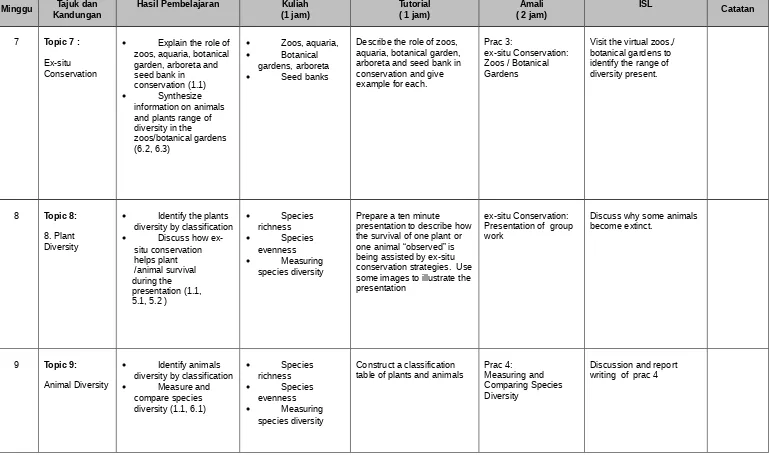PROGRAM: ____________________________________________________________________________ SEMESTER: ______ TAHUN: ______
Kursus: __________________________________________________________________________________________ Kod: ____________ Kredit: ____________
Minggu KandunganTajuk dan Hasil Pembelajaran (1 jam)Kuliah Tutorial( 1 jam) ( 2 jam)Amali ISL Catatan
1 Topic 1: Ecosystem I
Describe components of an ecosystem (1.1)
Explain how ecosystems function (1.1)
what are they ?
how do they
function? Refer to week 1 Reading
Overview of the course expectations and assessments
Briefing of the Practical Outline
Review of weekly readings Assessment Coursework: 60% Examination : 40%
2 Topic 2:
2. Ecosystems II
Compare & contrast different types of biomes (6.1) Explain the biodiversity complexity (1.1)
Synthesize information about soil ecosystem (6.2, 6.3)
types of
ecosystems locations
biodiversity, complexity and stability
Compare and contrast the different types of ecosystems in Malaysia
Preparation of practical 1:
Refer to week 2 Reading
Gather information from : http://soils.
usda.gov/sqy/concepts/soil _biology
Create soil food web
3 Topic 3: Ecosystem services
Explain the different types of biogeochemical cycles (1.1) Investigate the soil
ecosystems, collect data and present findings (6.1, 6.3) Discuss the ecosystem services (1.1)
Case Study : water case study and nutrient cycling
Ecosystem services
Study the different types of biogeochemical and nutrient cycles i.e.water, carbon, nitrogen, phosphorus and sulphur cycles
Prac 1:
Soil ecosystems – soil biota and food webs
Discussion and report writing of Prac 1
Work in groups and present the report
SCE3107 3 (2 + 1)
4 Topic 4: Biodiversity: Concept of species
Define species (1.1) Explain why we
value biodiversity (1.1)
What is it?
Why do we value
it?
The concept of
the species
Discuss what is biological diversity and its value
Prac 1:
Soil Ecosystems and data Collation
Discussion and critical review of week 4 readings
5 Topic 5: 5. Biodiversity: Endangered species
Explain how new species are formed and why species become extinct (1.1)
Synthesize
information on
endangered species in Malaysia (6.3, 7.5)
How do new
species arise?
What is
extinction?
Discussion and critical review of
Week 5 Readings
Prac 2:
When is it a Species? Taxonomy and Keeping Track of Biological Diversity
Gather information about endangered species in Malaysia and measures taken to address the problem
6 Topic 6 : In-situ Conservation
Identify and describe characteristics of natural habitats in Malaysia (1.1) Explain the
importance of natural population to mankind (1.1)
Natural
population
Natural habitats
Study the natural habitat of animals and plants in Malaysia and its importance to mankind”
Rainforest Mangrove
Fresh water/marine
Discussion and report writing of Prac 2
7 Topic 7 : Ex-situ Conservation
Explain the role of zoos, aquaria, botanical garden, arboreta and seed bank in conservation (1.1)
Synthesize
information on animals and plants range of diversity in the
zoos/botanical gardens (6.2, 6.3)
Zoos, aquaria,
Botanical
gardens, arboreta
Seed banks
Describe the role of zoos, aquaria, botanical garden, arboreta and seed bank in conservation and give example for each.
Prac 3:
ex-situ Conservation: Zoos / Botanical Gardens
Visit the virtual zoos,/ botanical gardens to identify the range of diversity present.
8 Topic 8: 8. Plant Diversity
Identify the plants diversity by classification Discuss how
ex-situ conservation helps plant /animal survival during the presentation (1.1, 5.1, 5.2 )
Species
richness
Species
evenness
Measuring
species diversity
Prepare a ten minute presentation to describe how the survival of one plant or one animal “observed” is being assisted by ex-situ conservation strategies. Use some images to illustrate the presentation
ex-situ Conservation: Presentation of group work
Discuss why some animals become extinct.
9 Topic 9: Animal Diversity
Identify animals diversity by classification
Measure and
compare species diversity (1.1, 6.1)
Species
richness
Species
evenness
Measuring
species diversity
Construct a classification
table of plants and animals Prac 4:Measuring and Comparing Species Diversity
10 Mid-Semester Break
11 School-Based Experience
12 Topic 10: Understanding population trends
Identify, describe and compare different population trends (1.1, 6.1)
Initial population size
Population growth factor
Carrying capacity
Hidden
Biodiversity
Identify and discuss population trends in developed and under developed countries
Prac 5: Understanding Population Trends
Discussion and critical review of week 11 readings
13 Topic 11: Threats to Biodiversity
Identify threats to wildlife
Suggest
preventive actions to curb wildlife poaching and trafficking (1.1, 6.1)
Wildlife poaching Wildlife trafficking
Discuss wild life threats in Malaysia
Discussion and report writing of prac 5
Discuss wild life threats in the world
14 Topic 12: Genetic diversity I
Explain how
gene pools relate to genetic variation (1.1) Analyze issues
in genetic diversity (6.1)
Gene pool
Genetic variation
Read the article ”Trouble in Paradise”. Analyze how the scientists maximize genetic diversity in re-introduced population?
Prac 6:
Measuring Genetic Diversity
15 Topic 13: Genetic diversity II
Identify the different types of genetic tools to measure genetic diversity (6.1)
Problems of small populations
Measuring
genetic diversity
Identify the different types of genetic tools to measure genetic diversity and describe their usage in crime scene investigation..
Discussion and report writing of prac 6
Analyze issues on “The conservation of genetic diversity”
16 Topic 14: Collecting data using geospatial technology
Identify a variety of technologies used to observe the behaviour, ecology and social of animals (1.1, 6.3) Investigate Eavesdropping on species such as elephants, birds, and whales using acoustic techniques
Solving problems using molecular techniques
Collecting data using remote techniques
Discuss the latest technologies used in collecting data and trekking animals.
Prac 7: Acoustic Ecology
Carry out investigation: Eavesdropping on species such as elephants, birds, and whales.
Complete exercise on Acoustic Ecology
17 Topic 15:
Conservation and sustainability
Describe how
conservation and sustainable development is achieved at the local and national level (1.1)
Conservation and human societies Biodiversity and
sustainability
Discuss environmental issues and their causes
Describe how conservation and sustainable
development achieved at the local and national level.
19 REVISION
20 REVISION
